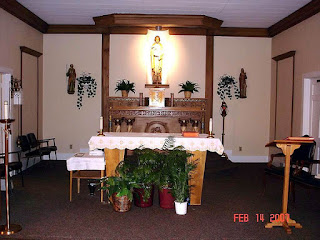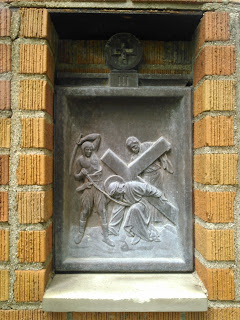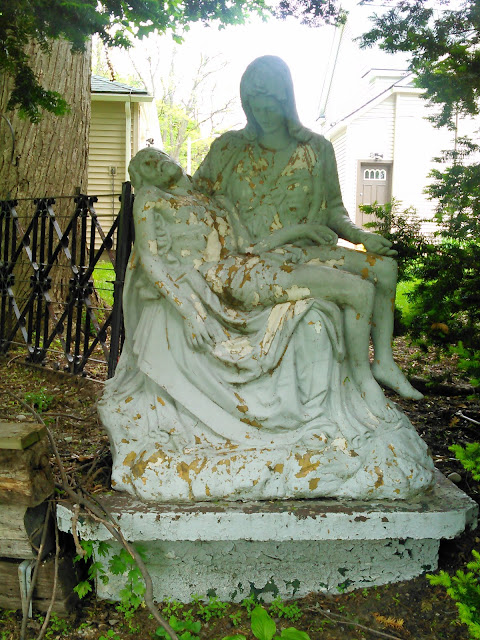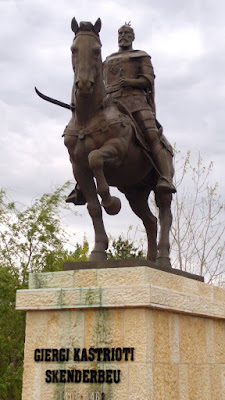In 1923, the League of Catholic Women approached Msgr. Grupaa and expressed the spiritual needs of the Polish-American community in Pontiac. The first parish formation meeting, led by Very Rev. Canon Anthony Makisimik, was held on March 18, the day before the Feast of St. Joseph.
With permission from Bishop Gallagher, the priests of SS. Cyril & Methodius Seminary soon established St. Joseph as a mission. The group collected money and purchased two lots on South Boulevard at the corner of Bagley, in the “Polish Hills” section of Pontiac. A white, frame church was soon built and, on August 10, 1924, the church was blessed and the first Mass was celebrated. Rev. Vincent Balcer briefly ministered there in 1925 before being replaced by Rev. Stanley Tenerowicz, who in turn led the Mission of St. Joseph for eight years.
The faithful stand in front of the church, before a series of renovations - Source
|
Rev. Theodore Kowalewski was appointed pastor in 1933 and the mission soon took on the status of a parish. During the Great Depression, the congregation shrank to only 14 families; they struggled financially and the pastor personally paid many of the expenses. Despite challenges, Fr. Kowalewski made improvements to the church building, brought back former parishioners and built the rectory. The Confraternity of Christian Doctrine was canonically erected in 1940 to provide for the education of elementary and high school children who were unable to attend a parochial school. However, all of this came with considerable debt.
 |
| Fr. Jarzembowski, a Tertiary of the Third Order of St. Francis - Source |
Rev. Bernard Mary Jarzembowski began his 23-year pastorate in 1939. Very displeased with the financial situation, he raised funds and liquidated the debt of $2,900 ($42,000 today). With great devotion, Fr. Jarzembowski established pilgrimages to honor the Blessed Virgin as well as many parish groups, such as the Confraternity of the Immaculate Heart of Mary. After World War II, Fr. Jarzembowski sought to enlarge the church, writing to the congregation:
My Dear Parishioners and Friends!
We are now quite well prepared to go ahead with the Reconstruction and Enlargement of our Church. We have saved $7,100 and the promises of various sums of money we ought to do a lot in order not to overburden ourselves with a big loan. That we must avoid. We want a pretty church with accommodations which are so badly needed, but we also want a debt no bigger than which we will be able to easily take care of.
I do hope that every Parishioner will understand, and this I expect, that all wage-earners, whether married or unmarried will contribute to this Holy Cause at least $50.00 each. Several have given already $100 and some will give more.
Let everyone do his best and, I am sure, that everyone will be very happy when they see how beautiful the Reconstruction will appear.
-- Rev. Dr. Bernard F. Jarzembowski, Pastor
In 1947-48, the church was reconstructed with only the side walls left intact. A basement was dug along with the additions of a sacristy, vestibule, confessionals and other amenities.
 |
| The exterior of the church after 1948 renovations - Source |
On August 17, 1952, both the grotto-chapel and the statue of the Sorrowful and Immaculate Heart of Mary were blessed. The statue, a gift of Fr. Jarzembowski, is made of Carrara marble and was sculpted in Italy. Below are a historic image (left) and a recent image (right).
The shrine quickly became a pilgrimage destination, particularly for First Saturdays and the Feast of the Immaculate Heart of Mary. About 1,200 pilgrims from many states came for the first pilgrimage, even from as far as Minnesota and New England. Pilgrims participating in this first pilgrimage witnessed Fr. Jarzembowski place the Golden Heart upon Our Lady of the Cape where it has remained ever since.
 |
| A 1955 postcard of the shrine - Source |
One pilgrim wrote about the experience in Historical Highlights of The Shrine of the Immaculate Heart of Mary (1960).
On the Sunday of the Pilgrimage (Aug. 17), Fr. Jarzembowski went in procession with the Ohio pilgrims to the Grotto before 6:00 a.m. and blessed the Statue, and chanted Mass for them in the church. Chartered buses from Saginaw, Bay City, Flint and other cities arrived before 8:00 a.m. His Excellency, Bishop Patrick Shanley, of Infanta, Quezon, Philippine Islands, came with them. He had Mass for them at 8:00. Other Masses followed, the last one at 12 noon. Pilgrims of Mt. Clemens and the Hungarian pilgrims chiefly attended this Mass.
A big solemn procession left the church with another smaller statue of Our Lady of the Cape, a gift of Detroit pilgrims…Just before the procession, Fr. Jarzembowski blessed the statue (this smaller statue appears to no longer be at the Shrine).
After the blessing of the Grotto, Bp. Shanley delivered a very inspiring sermon on the Most Blessed Virgin Mary and on devotion to Mary in the Philippines.
Rosary devotion was conducted by Fr. Jarzembowski.
Fr. Al Jarzembowski, brother of the pastor, and pastor of St. Josephat’s Church in Detroit, then brought the Most Blessed Sacrament in procession from the Church.
The Grotto-Chapel is the center of a special devotion every year on the very Feast of the Immaculate Heart of Mary, August 22, except Sundays because Sundays must be reserved for the Annual Pilgrimages. It is sponsored by the Daughters of Isabella of the Circle of the Our Lady of the Lakes. At this devotion, there is a torchlight procession, rosary in formation of a Living Rosary, sermon, prayers with act of Consecration to the Immaculate Heart of Mary and Benediction of the Most Blessed Sacrament.
Fr. Jarzembowski died in 1962, the year of his 50th anniversary as a priest. Rev. Francis Okonowski succeeded him and continued the pilgrimages, devotions and annual books. Due his poor health, Fr. Okonowski was replaced by Fr. Edward Popielarz in 1969.
Rev. Edward Popielarz served for 17 years until his death on December 6, 1986, and was succeeded by Rev. (later Msgr.) William Easton. He served as administrator in addition to his responsibilities at nearby St. Vincent de Paul and Sacred Heart Major Seminary.
 |
| St. Joseph Chapel, as it appeared before recent renovations - Source |
On October 11, 2009, the Pontiac parishes of St. Joseph, St. Vincent de Paul, and St. Michael the Archangel merged to form the new St. Damien of Molokai Parish. Fr. James Kean has served as pastor of St. Damien of Molokai Parish ever since. Because the parish couldn't afford to maintain three churches, St. Joseph Church closed in 2013 and was put up for sale.
 |
| The interior of St. Joseph, when it was still a parish church - Source |
At the same time, Terra Sancta, a Franciscan apostolate, was looking for a new home. Among other things, they lead biannual pilgrimages to the Holy Land.Terra Sancta began a $300,000 fundraising campaign to purchase and restore the chapel, shrine and grounds. Thankfully, the campaign was successful and the proceeds of the sale went to St. Damien of Molokai Parish. In turn, the parish was able to pay off its debts.
“I first saw this church in 2008, when Patti and I were part of a Franciscan retreat together...I saw this church and thought, I would really like to have this church one day. There is just so much that needed to happen; from St. Damien closing the place to us needing a place and being able to raise the money, you can just tell God wanted us here.”
“We had people from the community stop and ask when we are opening and thanking us for once again providing a quiet place for people to reflect and pray... We really want to restore St. Joseph’s role in Pontiac and bring back this beautiful devotion to Mary to the people in the community.”
The chapel recently reopened on May 13th of this year, on the centennial of the first apparition of Our Lady of Fatima.
The high altar was refinished and a large crucifix replaced statues of St. Joseph and other saints.
Among the most noticeable renovations: a stone facade was added to the front entrance as well as new siding.
Our Lady of the Cape, originally in the shrine, currently stands in a niche on the left side of the chapel. St. Joseph, brought from Saginaw's Cathedral of Mary of the Assumption, on the right side of the chapel.
A window in Our Lady's niche; the octagonal shape is usually associated with baptismal fonts and the niche may have been a baptistery at one time. The flower and star at center are traditionally recognized as Marian symbols.
Symbols of Christ and the four evangelists in the window above the doorway.
Outdoor Stations of the Cross, dating to the mid-1950s, stand along the perimeter of the property.
The last three Stations are weathered statues outside of the rectory.
A small, wooden altar stands behind the chapel, used for outdoor Masses.
According to University of Dayton, which maintains a library of Marian shrines, this is one of only six Marian shrines in the state of Michigan.
+ + + + + + + + + +
For more info: A Gift For Our Mother + Terra Sancta Pilgrimages + fundraising brochure
Articles in The Michigan Catholic: May 2014 + August 2015
More history: Polish-American Liturgical Center, history of St. Joseph Chapel,
history of the Shrine of the Immaculate Heart of Mary
Photos before the renovation: AOD Film Services



























































